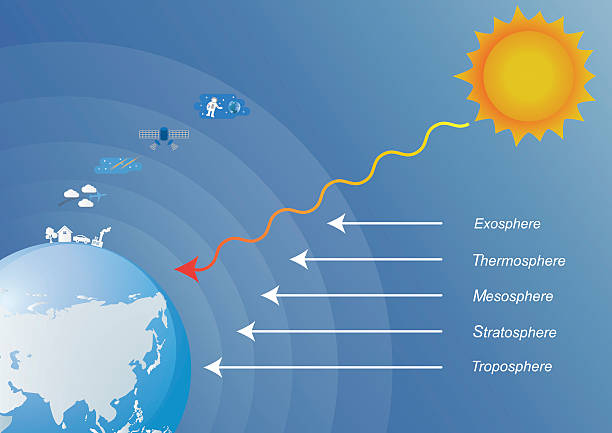What Is The Atmosphere ; G.K. Fact
WHAT IS THE ATMOSPHERE
INTRODUCTION –
Hello readers, if you are a student you can take enough knowledge about this topic. Or if you are willing to take some notes about this, then surely this article will help you for your assignment.
The systematically arranged points will help you to find the proper knowledge about it and this makes the article” what is the atmosphere” easy to read.
If my readers are not students, they just want to read it for gaining knowledge, then this article will be helpful for them, which is written in a more understanding way.
Yes, I will not go deep into the topic, but I will give you enough information for making good and useful knowledge for all of you.
The atmosphere is a mixture of gases that surrounds the planet. On Earth, the atmosphere helps to make life possible. Besides providing us with something to breathe, it shields us from most of the harmful ultraviolet( UV) radiation coming from the sun.
These harmful rays warm our earth’s surface by about 33 degrees Celcius via the greenhouse effects. The terrestrial atmosphere, by nature of its composition, control of temperature, and shielding effect against solar radiations makes life possible on the earth.
It covers both land and water surfaces. Without chemical processes involving several of the atmospheric gases, life could not exist.
The physical process, that operates in the atmosphere is also of vital importance because they are responsible for Earth’s varied climates. It is bound to Earth by the Gravitational pull of Earth.
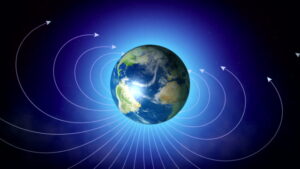
COMPOSITION OF THE ATMOSPHERE-
The composition of the atmosphere changes as we go higher from Earth’s surface. Up to about a height of 50 km from Earth, the atmosphere is composed of nitrogen( 78.09% ), oxygen ( 20.95% ),argon( 0.93%) ,minor gases( 0.03%) ,which includes carbon dioxide ,hydrogen, neon, helium, methane, xenon, krypton, etc.
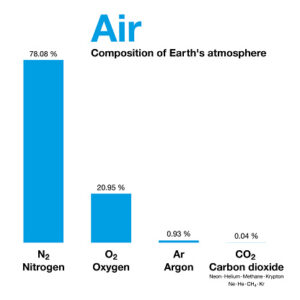
After a height of 50 km above the Earth’s surface, the atmosphere is made up of atomic oxygen, ozone, helium and hydrogen. The mixture of gases in the air today has had 4.5 billion years in which to evolve.
DO YOU KNOW HOW LIFE HAVE EVOLVED-
Gases, that erupts from volcanoes today, however, are mostly a mixture of Water Vapour, Carbon Di Oxide, Sulphur Di Oxide and Nitrogen with almost no Oxygen.
If this is the same mixture, that existed in the early atmosphere, then various processes would have had to operate to produce the mixture we have today. One of these processes was condensation.
As it cooled, much of the water vapour condensed to fill the earliest Oceans. Chemical reactions would also have occurred.
Some Carbon Di Oxide would have reacted with the rock of the Earth’s crust to form Carbonate minerals, and some would have dissolved in the new Oceans.
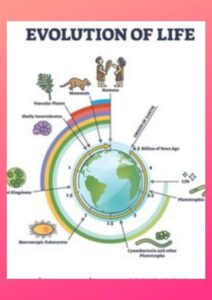
Later as primitive life capable of photosynthesis evolved in the Oceans. New marine organisms began to produce Oxygen.
Almost all the free oxygen in the air today is believed to have been formed by photosynthetic combinations of carbon dioxide and water.
About 570 million years ago, the Oxygen content of the atmosphere and oceans became high enough to permit marine life capable of respiration. Later some 400 million years ago, the atmosphere contained enough oxygen for the evolution of air-breathing land animals.
ATMOSPHERIC PRESSURE-
Atmospheric pressure refers to the weight of the entire air column over a given point. A litre of air weighs about 1.3 g. At sea level, the air pressure is around 1,033.6gcm square. This is referred to as 1 atmosphere. Air is held to the Earth by gravity.
This strong invisible force pulls the air downward, giving air molecules weight. The weight of the air molecules exerts a force upon the Earth and everything on it. The amount of force exerted on a unit surface area ( a surface that is one unit in length and one unit in width)is called atmospheric pressure or air pressure.
The air pressure at any level in the atmosphere can be expressed as the total weight of air above a unit surface area at that level in the atmosphere. Higher in the atmosphere, there are fewer air molecules pressing down from above.
Consequently, air pressure always decreases with increasing height above the ground. Because air can be compressed, the density of the air (the mass of the air molecules in a given volume ) is normally greatest at the ground and decreases at higher altitudes.
STRUCTURE OF THE ATMOSPHERE-
The atmosphere is broadly divided into two parts-homosphere and heterosphere. The homosphere extends up to the height of 90 km and is further divided into troposphere, stratosphere, mesosphere. Each of these layers is separated by a thin transition zone called ‘Pause’.
Above homosphere starts heterosphere, which has a layered structure of nitrogen, oxygen, helium and hydrogen. As the name suggests, the homosphere has a uniform or homogenous chemical composition, whereas the heterosphere is characterized by heterogeneous chemical composition.
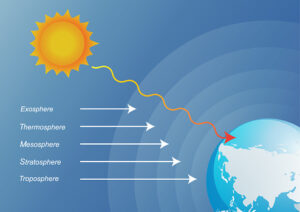
The altitude of various sub-layers is homosphere
Troposphere-0-16 km at the equator and 0-10 km at the poles,
Tropopause-10 km at poles to 16 km at the equator,
Stratosphere -10-16 to 50 km.
Stratopause-50 km.
Mesosphere-50 -85 km.
Mesopause—85-90 km.
and Heterosphere –
Thermosphere 90+km,
Ionosphere(Nitrogen layer-200 km, Oxygen layer -1110 km, Helium layer-1700 km, Hydrogen layer -2600 km, Exosphere and Magnetosphere (9600km).
ATMOSPHERIC LAYERS-
There are layers of air that lie above the earth’s surface. The atmosphere of the earth is arranged into four layers and three pauses. In order of increasing elevation, these are the Troposphere, the stratosphere, the mesosphere and the thermosphere.
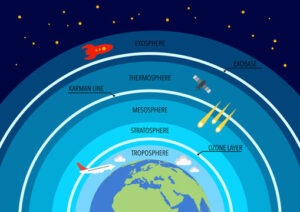
TROPOSPHERE-
The troposphere is the layer nearest to the Earth’s surface and extends from sea level to a height of about 15 km. This region is the densest of all the atmospheric layers and contains water vapour, moisture, and dust.
In this region, the temperature decreases as the height from the earth increases. The temperature of the troposphere is warmest in the tropical and subtropical climatic zones and coldest in the polar climatic zones. Water vapour concentration varies from trace amounts in polar regions to nearly 4 % in the tropics.
The most prevalent gases are Nitrogen( 78% ), Oxygen (21% ), with the remaining 1% consisting of Argon ( 0.9%) and traces of Hydrogen, Ozone, Methane, and other constituents. Carbon di Oxide is present in small amounts, but its concentration has nearly doubled since 1900.
The uneven heating of the regions of the troposphere by the sun causes convection currents, large scale patterns of wind that move heat and moisture around the globe. A common feature of the troposphere of densely populated areas is smog.
Read also…
TROPOPAUSE-
The tropopause is the layer that separates the troposphere ( lower layer) from the stratosphere( upper layer). It is the boundary between the troposphere and stratosphere. It lies about 15-20 km. above the Earth in the tropics and about 10 km. high in polar areas.
Whereas in the troposphere, the temperature generally decreases with height. Above the tropopause, the temperature no longer decreases. In some instances, it remains constant, at other times or other places, it remains it increases with height.
The tropopause is relatively cold because it is situated far from the two nearest good partial absorbers of sunlight – the earth surface and the ozone layer.
STRATOSPHERE-
It is the second-lowest of the four atmospheric layers. Its lower boundary is called the Tropopause and the upper boundary is the Stratopause. This is the region of uniform temperature, extending from an altitude of about 15 km above the earth to a height of about 50 km.
It is free from water vapour, clouds and dust. In contrast, the temperature in the Stratosphere remain the same or even increase with increasing height, which indicates vertical stability the stratospheric airflow is mainly horizontal.
Ultraviolet absorption by the ozone layer causes the high temperatures of the stratopause, which is usually between 48 km and 53 km (30 and 33 mi) above Earth surface.
MESOSPHERE-
This is a very cold region and lies above the ozone rich layer of the stratosphere. It extends from 50-80 km above the earth surface. It lies between a lower region of the atmosphere called the Stratosphere and an upper region, the Thermosphere.
The temperature of the Mesosphere decreases from about ‘0’ degrees Celcius at its lower boundary, called the Stratopause, to about -90 degrees Celcius at its upper boundary called Mesopause. The Mesosphere is the coldest layer of the atmosphere.
Above the Mesosphere lies the hot Thermosphere, where air temperature can exceed 1000 degrees Celcius.
Below the Mesosphere, the energy of incoming solar radiation is absorbed by both the earth’s surface and the ozone layer. The air rise in the Mesosphere, they retain their total heat energy. But expend and grow cooler. There is hence the drop in temperature in altitude.
IONOSPHERE-
The ionosphere is the part of Earth’s upper atmosphere, where ions and electrons are present in quantities sufficient to affect the propagation of Radio Waves. The ionosphere lies immediately above the mesosphere and extends from 60 to 400 km.
Above the Earth’s surface. This layer contains ionised air that protects the Earth from falling meteorites, as most of them burn out in this region. It also protects the earth from the harmful radiations of the Sun.
Read also…
THERMOSPHERE-
The thermosphere is the highest and largest of the four atmospheric layers. Its lower boundary is the mesopause, about 80 km above sea level, where the average temperature is a low of about -80 degrees Celcius.
Its upper layer is thermopause, about 600 km from sea level. At thermopause, the temperature may reach 225 degrees Celcius. At night during a period of minimum solar activity and 1475 degrees Celcius in the daytime during a period of maximum solar activity.
The upper part of the Thermosphere is so warm because it absorbs solar Ultraviolet Radiation. The Thermosphere is the only heterogeneous atmospheric layer. Vertical mixing takes place in the lowest 80 km of the Thermosphere, sometimes called the homosphere.
Above this height, however, the gravity pulls the heavier gases, Oxygen and Nitrogen towards the bottom of the Thermosphere. Thus the predominant gas molecules in the upper thermosphere become those of Helium and Hydrogen.
EXOSPHERE-
The region beyond the Thermosphere is called the Exosphere. Which extends to about 9600 km, the outer limit of the atmosphere. It is the uppermost region of the Ionosphere and makes up the outer limit of the atmosphere.
Here the gravity of the Earth is exceedingly weak. The magnetic belt of the Earth, which is known as the magnetosphere, extends to about 64000 km above the earth’s surface. The magnetosphere is the region above the earth surface in which charged particles are affected by the Earth’s magnetic fields.
The Exosphere is now considered as part of the Magnetosphere. The outer boundary of the Magnetosphere or the final boundary between the Earth and outer surface is known as its Magnetopause.
CONCLUSION-
I hope, “what is the atmosphere” article will help you in a lot of ways. You must have found sufficient knowledge about the atmosphere.
Thank You
Read also…
- What is the shape of the earth
- Uttarakhand visiting places
- An essay on importance of education
- The knowledge is power
- English short story for students
